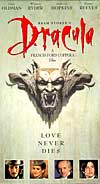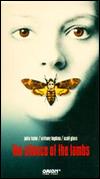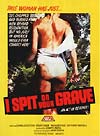 Other classic horror tales remade on celluloid in the 80s and afterwards included: The Bride (1985) with Jennifer Beals as the attractive 'bride of Frankenstein'
Other classic horror tales remade on celluloid in the 80s and afterwards included: The Bride (1985) with Jennifer Beals as the attractive 'bride of Frankenstein' - Joel Schumacher's teenage vampire film The Lost Boys (1987), with Kiefer Sutherland as vampire gang leader David hissing to newly-dead Michael (Jason Patric): "Now you know what we are, now you know what you are. You'll never grow old, Michael, and you'll never die, but you must feed"; also the film's closing line about the coastal town of Santa Carla: "One thing about living in Santa Carla I never could stomach... all the damn vampires"
- director Kathryn Bigelow's directorial debut film - the violent Western/vampire film Near Dark (1987)
- director Francis Ford Coppola's visually compelling and baroque Bram Stoker's Dracula (1992) with Gary Oldman as the blood-sucking, sexy and ruthless vampire and Anthony Hopkins as his crazed arch-nemesis Van Helsing
- director/actor Kenneth Branagh's British film (co-produced by Francis Ford Coppola) of the horror classic Mary Shelley's Frankenstein (1994) with Robert De Niro as the Creature and Helena Bonham-Carter as the doctor's distressed fiancee Elizabeth
- the over-the-top, star-studded vampire epic Interview with the Vampire: The Vampire Chronicles (1994) from director Neil Jordan that was partly based on Anne Rice's popular gothic vampire novels, and featured Tom Cruise as the roguish vampire Lestat
- the violent horror crime film From Dusk Till Dawn (1996) scripted by Quentin Tarantino
- John Carpenter's horror/western Vampire$ (1998) with James Woods as a vampire killer
- Wes Craven Presents: Dracula 2000 (2000), a loose adaptation of the original Bram Stoker novel
- Blade (1998) and the sequel Blade II (2002), with Wesley Snipes as the Marvel Comics half-vampire vampire slayer
- The Queen of the Damned (2002) - singer Aaliyah's last film based on author Anne Rice's popular book series The Vampire Chronicles
Other Notable Horror Films in the 80s and 90s:
Inventive fantasies with Gothic plots included:
- Michael Mann's visually and technically impressive WW II horror flick with evil Nazis titled The Keep (1983)
- producer Steven Spielberg's comedy/horror film Gremlins (1984) about cute little "mogwai" hand puppets that turn nasty; a sequel, Joe Dante's Gremlins 2: The New Batch (1990) provided both black comedy and a parody/satire with lots of in-jokes and cameos, a Donald Trump-like character, and a Busby Berkeley musical homage ("New York, New York") performed by the gremlins
- the summer blockbuster comedy spoof Ghostbusters (1984) about paranormal investigators in the Big Apple
- director George Miller's excessively decadent The Witches of Eastwick (1987) about the sexual liberation of three small-town New England women (Cher, Susan Sarandon, and Michelle Pfeiffer) through Jack Nicholson's Mephisto (Daryl Van Horne)
- director Arthur Penn's gothic horror thriller/film noir Dead of Winter (1987) with Mary Steenburgen in a multiple role as a victimized woman in a remote cabin during a blizzard
- Adrian Lyne's Fatal Attraction (1987) with the merging of horror and suspense/thriller genres with a manipulative film about a spurned, deadly woman
- Nicolas Roeg's The Witches (1990) with Anjelica Huston as the chief witch
British writer/director Clive Barker made his directorial debut with the graphically grisly Hellraiser (1987) featuring nasty Cenobites, followed by innumerable sequels. Another British director, Bernard Rose, made the nightmarish fantasy Paperhouse (1989) and directed Clive Barker's terrifying, violent tale Candyman (1992) about a reincarnated, hook-handed, formerly-tortured and murdered slave nicknamed "Candyman" who enticed female urban legends researcher Helen Lyle (Virginia Madsen) to "Be my victim."
 In 1990, Kathy Bates won the Best Actress Oscar for her portrayal of a sick celebrity fan in Misery (1990), based on another Stephen King novel. The first film to feature the evil psychiatrist Hannibal Lecter was Michael Mann's slick Manhunter (1986). Respectability was awarded to the horror film genre when director Jonathan Demme's shocking horror/thriller The Silence of the Lambs (1991), starring Anthony Hopkins as the murderous 'Hannibal the Cannibal' and Jodie Foster as a vulnerable FBI agent, walked away with five major Academy Awards - a clean sweep. Further derivations of the original films included Ridley Scott's Hannibal (2001) and Brett Ratner's prequel Red Dragon (2002) - a remake of Manhunter.
In 1990, Kathy Bates won the Best Actress Oscar for her portrayal of a sick celebrity fan in Misery (1990), based on another Stephen King novel. The first film to feature the evil psychiatrist Hannibal Lecter was Michael Mann's slick Manhunter (1986). Respectability was awarded to the horror film genre when director Jonathan Demme's shocking horror/thriller The Silence of the Lambs (1991), starring Anthony Hopkins as the murderous 'Hannibal the Cannibal' and Jodie Foster as a vulnerable FBI agent, walked away with five major Academy Awards - a clean sweep. Further derivations of the original films included Ridley Scott's Hannibal (2001) and Brett Ratner's prequel Red Dragon (2002) - a remake of Manhunter.Cape Fear (1991), a Martin Scorsese remake of the early 60's classic with Robert Mitchum as a psychopathic stalker, starred Oscar-nominated Robert DeNiro as a creepy, Freddy Krueger-like paroled convict. The disturbing Jacob's Ladder (1990) featured a Vietnam vet (Tim Robbins) troubled with nightmares due to possible military experiments with LSD and other family traumas. In 1992, the controversial suspense/erotic thriller Basic Instinct (1992) produced pure horror in its story of a beautiful, bi-sexual murder suspect. David Fincher's thriller-horror film Se7en (1995) followed two NY homicide cops (Morgan Freeman and Brad Pitt) as they tracked down a serial killer (Kevin Spacey) known for displaying the 'seven deadly sins' at his murder scenes.
A few other horror films in the mid-1990s surprised the industry with their phenomenal success and return to slasher themes. Each of them provided an attractive and hip young cast: The Craft (1996) about schoolgirls dabbling in witchcraft and black magic, Wes Craven's horror/thriller Scream (1996) (see above), and I Know What You Did Last Summer (1997), about teens covering up a fatal hit-and-run accident - with expected horrific results.
The end of the century's low-budget docu-horror The Blair Witch Project (1999) was filmed as an expressionistic, hand-held video and captured the public's attention with its suggestive and understated horror. Similarly, M. Night Shyamalan's ghost story The Sixth Sense (1999) created suspense without the typical formulaic and explicit elements of most slasher films. Director Mark Pellington's X-Files like The Mothman Prophecies (2002), starring Richard Gere and Laura Linney, was a psychological thriller/horror film based on a legendary 'true' creature with mothlike features and red eyes in Point Pleasant, WV.
Lucrative Horror Film Retreads in the New Century:
 One of the most effective, intelligent and stylish horror films of the new decade was Gore Verbinski's The Ring (2002) - a modern-day, gothic horror classic, a remake of the Japanese horror flick Ringu (1998). Other horror films were retreads of successful foreign classics (i.e., The Grudge (2004) and Dark Water (2005)). These films were low cost to produce; didn't require much originality, big-name (and salary) actors or extensive marketing (because of brand-name recognition); and they had ready-made legions of faithful horror-film devotees. One thing most of the films had in common - they were not favorites of the film critics.
One of the most effective, intelligent and stylish horror films of the new decade was Gore Verbinski's The Ring (2002) - a modern-day, gothic horror classic, a remake of the Japanese horror flick Ringu (1998). Other horror films were retreads of successful foreign classics (i.e., The Grudge (2004) and Dark Water (2005)). These films were low cost to produce; didn't require much originality, big-name (and salary) actors or extensive marketing (because of brand-name recognition); and they had ready-made legions of faithful horror-film devotees. One thing most of the films had in common - they were not favorites of the film critics.Film making studios realized that lucrative profits could be scored by cheaply remaking or 're-treading' classic horror films. Many were watered-down, familiar films without any further originality, such as the following:
- the re-release of Exorcist: The Version You Haven't Seen Before (2000)
- The Texas Chainsaw Massacre (2003) and The Texas Chainsaw Massacre: The Beginning (2006)
- Freddy vs. Jason (2003)
- the prequel Exorcist: The Beginning (2004)
- Dawn of the Dead (2004)
- Alien vs. Predator (2004)
- The Grudge (2004) (a remake of Ju-on: The Grudge (2003, Jp.)) and The Grudge 2 (2006)
- The Amityville Horror (2005)
- Dark Water (2005) (a remake of Honogurai mizu no soko kara (2002, Jp.) (aka Dark Water))
- The Fog (2005)
- House of Wax (2005)
- Saw II (2005)
- The Bad Seed (2006)
- Bride of Frankenstein (2006)
- The Last House on the Left (2006)
- The Hills Have Eyes (2006) and The Hills Have Eyes II (2007)
- The Wicker Man (2006)
- The Omen (2006) (released, of course, on 6/6/06)
- Prom Night (2006)
- Saw III (2006)
- TheTingler (2006)
- The Birds (2007)
- The Blob (2007) (the SECOND remake!)
- Creature From the Black Lagoon (2007)
- Death Race 3000 (2007)
- Don't Look Now (2007)
- The Entity (2007)
- Gaslight (2007)
- The Hitcher (2007)
- Hostel: Part II (2007)
- Creepshow (2008)
- The Wolf Man (2008)
Sadistic Horror of the New Millenium:
 One of the newest trends of horror were variations on the sadistic, low-budget "trash" horror Z-films of the 1970's, many of which featured rape-revenge themes, in such films as:
One of the newest trends of horror were variations on the sadistic, low-budget "trash" horror Z-films of the 1970's, many of which featured rape-revenge themes, in such films as:- Marc B. Ray's R-rated slasher Scream Bloody Murder (1972), advertised as the first "gore-nography" film
- Wes Craven's crude The Last House on the Left (1972)
- Bo A. Vibenius' graphic Thriller: A Cruel Picture (1974, Sweden)
- Nico Mastorakis' shocking and upsetting Island of Death (1975)
- Jim Sotos' Forced Entry (1975)
- Lamont Johnson's Lipstick (1976)
- Frederick R. Friedel's exploitative Axe (1977) (aka Lisa, Lisa and The California Axe Massacre)
- Pasquale Festa Campanile's bloody Hitch-Hike (1977, It.)
- Meir Zarchi's brutal Day of the Woman (1978) (aka I Spit on Your Grave)
- Ruggero Deodato's semi-documentary bloodbath Cannibal Holocaust (1979, It.)
- Abel Ferrara's violent horror-crime revenge fantasy Ms. 45 (1981) (aka Angel of Vengeance)
 In the new century, film audiences' threshold for sadistic gore and sickening violence (already numbed by years of 'slasher' films) was seriously tested, in such low-budget scarefest films as William Malone's hellishly dark and torture-filled FearDotCom (2002), and James Wan's grisly Saw (2004) (with lucrative sequels in 2005, 2006 and 2007), which featured a sadistic serial killer named Jigsaw who devised maddening, diabolical deathtraps for his victims. Also, there was Alexandre Aja's blood-soaked The Hills Have Eyes (2006) (a remake of Wes Craven's controversial 1977 cult low-budget film of the same name, and actually produced by Craven) with a psychopathic, mutated family of cannibals attacking a suburban family in the Nevada desert, and Eli Roth's xenophobic and uncompromising Hostel (2005), which told of two hedonistic American male backpacking tourists in Europe who were subjected to debased, medically-graphic physical, sexual and mental torture in the concluding 20 minutes. Other male film-makers who were contributing to this new violently-graphic trend included Rob Zombie (The Devil's Rejects (2005), the sequel to House of 1000 Corpses (2003)).
In the new century, film audiences' threshold for sadistic gore and sickening violence (already numbed by years of 'slasher' films) was seriously tested, in such low-budget scarefest films as William Malone's hellishly dark and torture-filled FearDotCom (2002), and James Wan's grisly Saw (2004) (with lucrative sequels in 2005, 2006 and 2007), which featured a sadistic serial killer named Jigsaw who devised maddening, diabolical deathtraps for his victims. Also, there was Alexandre Aja's blood-soaked The Hills Have Eyes (2006) (a remake of Wes Craven's controversial 1977 cult low-budget film of the same name, and actually produced by Craven) with a psychopathic, mutated family of cannibals attacking a suburban family in the Nevada desert, and Eli Roth's xenophobic and uncompromising Hostel (2005), which told of two hedonistic American male backpacking tourists in Europe who were subjected to debased, medically-graphic physical, sexual and mental torture in the concluding 20 minutes. Other male film-makers who were contributing to this new violently-graphic trend included Rob Zombie (The Devil's Rejects (2005), the sequel to House of 1000 Corpses (2003)). This new genre of "pseudo-snuff films" (dubbed "horror-porn", "torture-chic", "gore-nography" and "claustrophobic cruelty"), was accused of being like a "sicko video game" - containing visceral violence and unheard-of human suffering - that severely tested the limits of R ratings. A new variation on horror films was the blending of 'chick-flicks' with a traditional horror-adventure film, exemplified by Lions Gate's claustrophic and terrifying The Descent (2005, UK) - one of the first all-female brutal action horror films. This little British production from director Neil Marshall told about six athletic, extreme cave-plunging spelunkers (six unknown actresses) who faced various horrors (predatory humanoid underground dwellers) in the thick darkness of an Appalachian cavern - without any instances of nudity, gratuitous body shots, or sex.
0 yorum:
Yorum Gönder